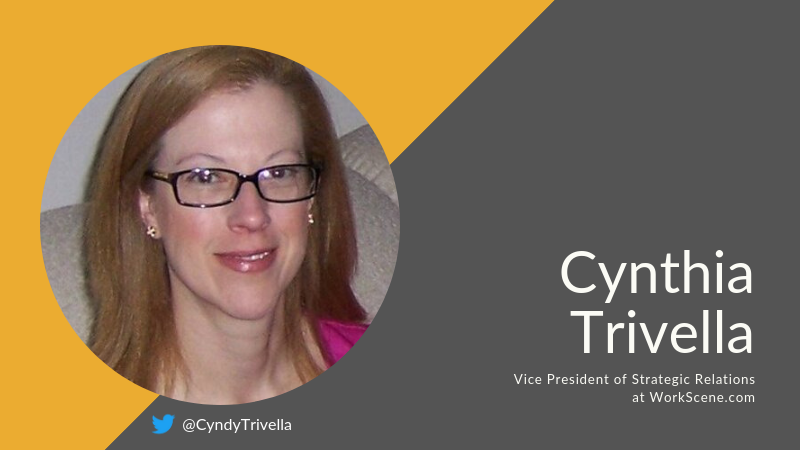Q&A with Cynthia Trivella, Vice President of Strategic Relations at WorkScene.com, on the Evolution of HR
Cynthia Trivella is Vice President of Strategic Relations at WorkScene.com. She has worked in HR marketing for over 20 years and partnered with leading global brands to help them attract and engage employees. We recently spoke with Trivella about the evolution of HR and the need to rethink our approach when recruiting tomorrow’s talent.
What do you think are the most important issues for HR leaders to focus on right now?
The list of important issues is pretty long, but I would say that talent attraction, retention, and employee engagement are somewhere at the top. Without people, brands cannot thrive or even exist. Customers cannot be served. Products cannot be created. Sales cannot be made. Revenue cannot be generated. As I wrote in a recent blog article, at the end of the day, business runs on two things: people and processes, and without them in synergistic coexistence, desired results cannot happen.
How is the low unemployment rate complicating things?
I don’t believe this is what’s keeping organizations from finding people; I believe it’s the shortage of skills that is complicating hiring today. With the advent of the technology boom and information age has come a need for people with certain, defined skillsets, and we’re simply lacking on that front. In some part, this is because the U.S. educational system and U.S. businesses need to get on the same page to discuss gaps and needs, and they’re not good at doing this. Another step would be for employers to spend more time and budget on training, retraining, and educating their existing employee pool. This not only gives people a chance to learn new skills but also gives them a stretch exercise in growing their hard and soft skills.
Do you have any advice about improving recruiting and retention?
These processes are generally pretty fractured in most companies. All too often, people are hired based on skills exclusively. We need to look beyond that and think of how a new hire and his role will play out in the short- and long-term benefit of the company AND if the company has the attributes the new hire needs to stay engaged. Further, hiring companies need to show their human side of the business. People don’t identify with bricks and mortar, nor the images on a company’s website. They identify with other people, and unfortunately, many companies don’t take advantage of this opportunity.
When recruiting, it’s vital that the hiring company has a process that will not torment candidates along their interview journey with an excessive number of interviews and long, drawn-out periods when there’s no communication. A very wise person once told me: When you’re interviewing with a company, and the recruiting process is painful, expect that being an employee is not going to be any better. That advice stuck with me, and as someone who’s been a volunteer helping advise and assist job seekers for over 13 years, I have shared this advice with many people.
Also, when it comes to hiring and retaining, it’s vital for companies to focus on “culture add” rather than exclusively on “culture fit.” Culture add is when a new hire brings something different to the position, which can be in the form of a new design, new experience, new vision, new approach, an innovative strategy, a fresh perspective — really anything different. An employee who is a culture add accentuates what already exists in your culture but also adds a different dimension that was lacking and sorely needed. These people tend to be the game-changer when it comes to innovation.
What are your thoughts on candidate assessment tools? Is there a right and a wrong way to utilize them?
To me, it comes down to two things: Did you purchase an assessment tool that fits your organization’s hiring needs? And two, have the people using it been adequately trained on how to use it successfully? Yes, there are pros and cons to using assessment tools, but I believe the pros outweigh the cons. There is bona fide research that shows when companies use assessment tools, they get better quality hires, experience less turnover, and given that hiring is more costly than retaining, it makes good financial sense to conduct skills assessments and pre-screening. And the most significant benefit of all is it helps eliminate the natural biases that all people have by taking the human equation out of the picture.
How is technology transforming HR for better or for worse?
Technology is only as good as the people using it. Anyone who believes that technology is a panacea to cure all their work ails is going to be desperately disappointed. Technology is here to enhance, streamline, inform, guide, reduce redundant and mundane tasks, and most importantly, in my mind, allow us the time and opportunity to make more thoughtful, researched decisions.
The one thing technology will never do is replace human interaction. As companies acquire new HR technology, considerations for the end-users, as well as the person overseeing the functionality of the technology, need to be at the forefront of why HR needs this new tech, and further how they plan to use it and have others use it. So, best to go in with eyes wide open and don’t get misled by the object du jour. A particular technology may work wonderfully in one company but disastrously in another. It’s important to vet out technology providers and make sure that what you’re considering is right for your particular organization.
What will it take for HR to adapt for tomorrow and continue to deliver value to organizations?
Stop talking and start doing. Conversation is great, but without execution, it’s an exercise in futility. Don’t just talk about wanting to be part of the change; be the change you know is necessary.



